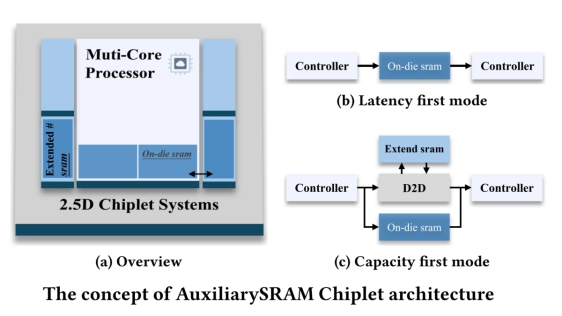AuxiliarySRAM: Exploring Elastic On-Chip Memory in 2.5D Chiplet Systems Design
By Zichao Ling, Lin Li, Yi Huang, Yixin Xuan, Jianwang Zhai, Kang Zhao
Beijing University of Posts and Telecommunications, China

Abstract
 The “Memory Wall” dilemma remains a critical challenge in modern computing systems. While latency-sensitive applications increasingly rely on costly on-chip SRAM to meet performance requirements, SRAM scaling faces bottleneck. Currently, Chiplet-based techniques present a promising solution to this challenge by enabling optimized trade-offs between latency, capacity, and cost.
The “Memory Wall” dilemma remains a critical challenge in modern computing systems. While latency-sensitive applications increasingly rely on costly on-chip SRAM to meet performance requirements, SRAM scaling faces bottleneck. Currently, Chiplet-based techniques present a promising solution to this challenge by enabling optimized trade-offs between latency, capacity, and cost.
This paper introduces AuxiliarySRAM, a design methodology that decouples SRAM resources into on-die and extended chiplets, enabling elastic capacity-latency scaling. Key contributions include: (1) a lightweight network-on-chip (NoC) with simplified crossbars, dual local ports, and address prediction to reduce average latency by 49.29% and boost bandwidth by 79.35%; (2) a evaluation framework integrated with Bayesian optimization (BO) to resolve Pareto-optimal on/off-die capacity ratios, accelerated by pruning strategies (1.93× speedup); and (3) system-level evaluation provides Pareto frontier-based design guidelines and demonstrates its cost-saving advantages.
Keywords:
Memory Architecture, Chiplet System, Lightweight Network on Chip, Design Space Exploration
To read the full article, click here
Related Chiplet
- Interconnect Chiplet
- 12nm EURYTION RFK1 - UCIe SP based Ka-Ku Band Chiplet Transceiver
- Bridglets
- Automotive AI Accelerator
- Direct Chiplet Interface
Related Technical Papers
- Signal Integrity Challenges in Chiplet-Based Designs: Addressing Performance and Security
- Thermal Implications of Non-Uniform Power in BSPDN-Enabled 2.5D/3D Chiplet-based Systems-in-Package using Nanosheet Technology
- Multi-Chiplet Marvels: Exploring Chip-Centric Thermal Analysis
- Universal Chiplet Interconnect Express: An Open Industry Standard for Memory and Storage Applications
Latest Technical Papers
- LaMoSys3.5D: Enabling 3.5D-IC-Based Large Language Model Inference Serving Systems via Hardware/Software Co-Design
- 3D-ICE 4.0: Accurate and efficient thermal modeling for 2.5D/3D heterogeneous chiplet systems
- Compass: Mapping Space Exploration for Multi-Chiplet Accelerators Targeting LLM Inference Serving Workloads
- Chiplet technology for large-scale trapped-ion quantum processors
- REX: A Remote Execution Model for Continuos Scalability in Multi-Chiplet-Module GPUs